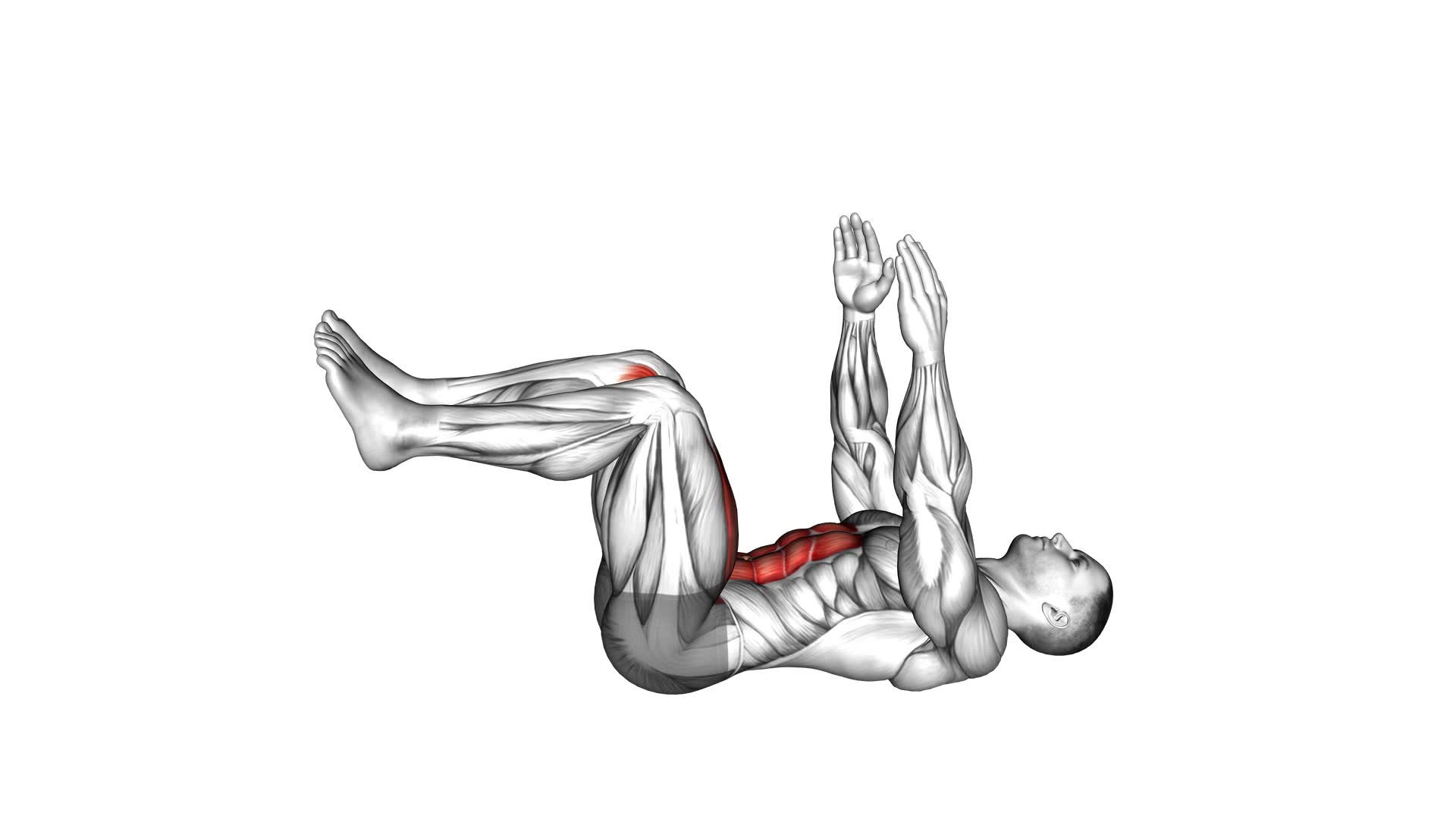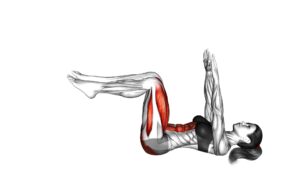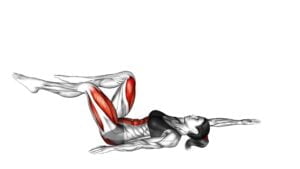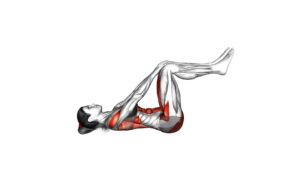Dead Bug – Video Exercise Guide & Tips

Are you looking to strengthen your core and improve your stability? Look no further than the dead bug exercise!
Watch This Exercise Video
In this video exercise guide, we'll walk you through the proper form and technique, as well as common mistakes to avoid.
Plus, we'll provide modifications and progressions to challenge you at any fitness level.
Get ready to maximize your dead bug workout with our helpful tips and sample routine. Let's get started!
Key Takeaways
- The Dead Bug exercise targets multiple muscle groups simultaneously, including the abs, glutes, hip flexors, and lower back.
- It is crucial for overall fitness and daily activities, as it enhances core strength, stability, balance, and posture.
- Proper form and technique are essential to maximize the benefits of the Dead Bug exercise and prevent strain or injury.
- Breathing techniques, such as diaphragmatic breathing, can improve stability and optimize the effectiveness of the exercise.
Benefits of the Dead Bug Exercise
One of the main benefits of the Dead Bug exercise is that it targets multiple muscle groups simultaneously. This engaging abs exercise not only works your core, but also engages your glutes, hip flexors, and lower back. By involving these various muscle groups, the Dead Bug exercise helps to improve overall core strength and stability.
The Dead Bug exercise is particularly effective for strengthening and toning your abs. As you perform the exercise, you have to engage your abs to maintain stability and control throughout the movement. This constant engagement of your abs helps to strengthen and define them, leading to a more toned and sculpted midsection.
In addition to targeting your abs, the Dead Bug exercise also works your obliques, which are the muscles on the sides of your waist. By twisting and reaching your opposite arm and leg, you engage your obliques and promote better definition and strength in these muscles.
By regularly incorporating the Dead Bug exercise into your fitness routine, you can improve your core strength and stability, leading to better posture, balance, and overall functional fitness.
Proper Form and Technique for the Dead Bug
Now let's talk about the proper form and technique for performing the Dead Bug exercise.
It's important to understand the significance of core stability in this exercise, as it's the foundation of your movements.
To ensure you're getting the most out of this exercise, it's crucial to avoid common form mistakes that can hinder your progress.
Additionally, mastering the breathing techniques for stability will help you engage your core effectively and maintain control throughout the movement.
Core Stability Importance
To achieve optimal results in the dead bug exercise, ensure that you maintain core stability through proper form and technique. Core stability is crucial not only for the dead bug exercise but also for overall fitness and daily activities. A strong and stable core provides a solid foundation for movement and helps prevent injuries.
By engaging your core muscles during the dead bug exercise, you can enhance your balance, stability, and posture. This exercise specifically targets the deep muscles of the abdomen, lower back, and pelvis, which are essential for core stability. Incorporating effective core exercises like the dead bug into your routine can improve your athletic performance, increase functional strength, and enhance your overall fitness level.
Now, let's move on to common form mistakes to avoid during the dead bug exercise.
Common Form Mistakes
To ensure proper form and technique for the dead bug exercise, it's important that you avoid common form mistakes.
One common mistake is lifting your head and neck off the ground, which can strain your neck muscles. Instead, keep your head and neck relaxed and in a neutral position.
Another mistake is arching your back excessively, which can put unnecessary stress on your lower back. To prevent this, engage your core muscles and maintain a slight natural curve in your spine.
Lastly, be mindful of your breathing. Many people hold their breath during the exercise, which can hinder stability. Remember to breathe deeply and steadily throughout the movement.
By avoiding these common mistakes and focusing on proper technique, you can maximize the benefits of the dead bug exercise.
Now, let's move on to the next section about breathing techniques for stability.
Breathing Techniques for Stability
To maintain stability and ensure proper form and technique for the dead bug exercise, it's crucial for you to focus on your breathing. Breathing plays a key role in stability training, as it helps engage your core muscles and maintain control throughout the movement.
When performing the dead bug, make sure to practice diaphragmatic breathing. This means taking deep breaths into your belly, allowing it to expand as you inhale and contract as you exhale. This type of breathing promotes stability by activating the deep abdominal muscles and providing support for your spine.
By incorporating diaphragmatic breathing into your dead bug exercise, you can maximize the effectiveness of the movement and enhance your overall stability.
Now let's discuss some common mistakes to avoid during the dead bug.
Common Mistakes to Avoid During the Dead Bug
When doing the dead bug exercise, it's important to focus on maintaining proper form. This means keeping your lower back pressed firmly against the ground and engaging your core muscles throughout the movement. Avoid common mistakes such as arching your back or letting your legs drop too low, as these can take away from the effectiveness of the exercise.
Remember to also pay attention to your breathing, exhaling as you extend your limbs and inhaling as you bring them back in.
Proper Form Importance
Avoid common mistakes during the Dead Bug exercise by focusing on proper form. Proper form is important because it ensures that you're effectively activating your core muscles and maintaining proper alignment throughout the movement.
To activate your core, engage your abdominal muscles by drawing your belly button towards your spine. This will help stabilize your pelvis and protect your lower back.
Additionally, maintaining proper alignment is crucial to prevent any strain or injury. Make sure your lower back stays pressed into the floor, while your hips and knees are bent at a 90-degree angle. Keep your head and neck relaxed, and avoid any excessive arching or rounding of your back.
Engaging Core Muscles
Maintain proper engagement of your core muscles to maximize the effectiveness of the Dead Bug exercise and prevent common mistakes. Engaging your core muscles is crucial for performing the Dead Bug correctly and reaping its benefits for your core strength.
To ensure you're engaging your core muscles properly, keep the following in mind:
- Focus on your breath: Take deep inhales and exhales throughout the exercise to engage your deep abdominal muscles and stabilize your core.
- Avoid overarching your lower back: Keep your lower back pressed against the floor to maintain proper alignment and prevent strain on your back.
- Keep your core tight: Imagine pulling your belly button towards your spine to activate your core muscles and maintain stability throughout the movement.
Breathing Techniques While Exercising
To properly execute the Dead Bug exercise and avoid common mistakes, it's important to focus on your breathing techniques. Proper breathing during exercise plays a crucial role in maximizing your workout and improving overall performance.
When you take deep breaths, you supply your muscles with the oxygen they need, enhancing their efficiency and endurance. To improve breathing efficiency during workouts, try to inhale deeply through your nose, filling your lungs completely, and then exhale through your mouth. This technique allows for better oxygen intake and carbon dioxide release.
Another effective technique is to synchronize your breath with your movements, exhaling on exertion and inhaling on the return phase. By practicing these breathing techniques, you'll be able to maintain control, optimize your energy, and get the most out of your Dead Bug exercise.
Modifications and Progressions for the Dead Bug
To modify or progress the Dead Bug exercise, you can incorporate variations that challenge your core muscles in different ways. Here are three modifications and progressions to consider:
- Single-Leg Dead Bug: Start by lying on your back with both knees bent and feet flat on the floor. Lift one leg off the ground, keeping it at a 90-degree angle. From this position, perform the Dead Bug exercise, extending your opposite arm and leg while maintaining stability in your core. This variation increases the difficulty by requiring more balance and stability.
- Weighted Dead Bug: Hold a dumbbell or a medicine ball in your hands while performing the Dead Bug exercise. The added weight increases the resistance and forces your core muscles to work harder to maintain stability.
- Banded Dead Bug: Attach a resistance band around your feet or ankles and anchor it to a stationary object. As you perform the Dead Bug exercise, the resistance from the band challenges your core muscles even more, making it a great progression for those who want to take their workout to the next level.
By incorporating these modifications and progressions into your Dead Bug exercise routine, you can continuously challenge your core muscles and make progress towards achieving your fitness goals. Remember to maintain proper form and listen to your body to prevent any injuries.
Keep pushing yourself, and you'll see improvements in your core strength and stability.
Tips for Getting the Most Out of Your Dead Bug Workout
Get maximum results from your Dead Bug workout with these essential tips.
- Focus on proper form and technique. Begin by lying flat on your back with your arms extended towards the ceiling and your knees bent at a 90-degree angle.
- Engage your core muscles by drawing your belly button towards your spine.
- Keep your lower back pressed into the floor to maintain stability as you extend one leg and the opposite arm.
- Increase the intensity by trying variations such as straightening both legs or adding a resistance band around your feet.
- Modify the exercise by placing your hands under your lower back for added support or using a stability ball for an extra challenge.
By incorporating these tips into your Dead Bug workout, you'll be able to target your core muscles effectively and maximize the benefits of this exercise.
Now, let's move on to a sample Dead Bug workout routine that you can try.
Sample Dead Bug Workout Routine
Now let's dive into the sample Dead Bug workout routine to further enhance your core strength and stability. This routine consists of three variations of the Dead Bug exercise that will challenge your core muscles in different ways.
Here is the sample workout routine:
- Basic Dead Bug: Lie on your back with your arms extended towards the ceiling and your knees bent at a 90-degree angle. Slowly extend one leg and the opposite arm towards the floor while keeping your lower back pressed into the ground. Return to the starting position and repeat on the other side. Perform 10 repetitions on each side.
- Dead Bug with Stability Ball: Place a stability ball between your knees and squeeze it tightly. Perform the same movement as the basic Dead Bug, but this time, keep your legs together and press the stability ball with your knees. This variation adds an extra challenge to your core muscles. Perform 10 repetitions on each side.
- Dead Bug with Resistance Band: Attach a resistance band around your feet and hold the other end with your hands. Perform the same movement as the basic Dead Bug, but this time, add resistance by pulling the band towards your body. This variation increases the difficulty of the exercise and activates more muscles in your core. Perform 10 repetitions on each side.
Frequently Asked Questions
How Many Calories Does the Dead Bug Exercise Burn?
The dead bug exercise is a great way to strengthen your core and improve your stability.
When it comes to burning calories, the burn rate will depend on factors like your weight, intensity level, and duration of the exercise.
The dead bug exercise is more focused on building strength rather than burning a significant amount of calories.
However, incorporating it into a well-rounded workout routine can contribute to overall calorie burn and help you achieve your fitness goals.
Can the Dead Bug Exercise Help Improve Posture?
The dead bug exercise can definitely help improve your posture. By engaging your core muscles and promoting stability, this exercise targets the muscles in your abdomen, lower back, and hips.
It also helps to strengthen your glutes and improve spinal alignment. To get the full benefits, it's important to maintain proper form throughout the exercise. So, make sure to keep your lower back pressed against the floor and your core engaged.
Is the Dead Bug Exercise Suitable for Individuals With Lower Back Pain?
If you're dealing with lower back pain, you might wonder if the dead bug exercise is suitable for you. Well, let me tell you, it can actually be quite beneficial!
The dead bug exercise can help strengthen your core muscles, which in turn can support your lower back and improve your posture.
Plus, there are modifications you can make to the exercise to accommodate any pain or discomfort you may have.
Can the Dead Bug Exercise Be Done by Beginners?
Yes, beginners can definitely do the dead bug exercise! It's a great way to improve your core strength.
By doing dead bug modifications, like starting with your legs bent or using an exercise ball, you can make it easier for yourself.
The dead bug exercise targets your abs, lower back, and hip muscles, helping you build stability and balance.
Are There Any Variations of the Dead Bug Exercise for Targeting Specific Muscle Groups?
Looking for variations or modifications to target specific muscle groups with the dead bug exercise? You're in luck! There are plenty of ways to switch it up and focus on different areas.
By adding resistance bands or weights, you can increase the intensity and work your muscles even harder.
Want to target your obliques? Try adding a twist at the top of the movement.
The dead bug exercise offers endless possibilities to challenge and sculpt your body.
Conclusion
In conclusion, the dead bug exercise is an effective workout that targets your core muscles and improves your stability.
By following proper form and technique, you can maximize the benefits and avoid common mistakes.
Additionally, there are modifications and progressions available to challenge yourself as you get stronger.
Remember to incorporate the dead bug into your workout routine and follow these tips to make the most out of this exercise.
Get ready to strengthen your core and improve your overall fitness!

Author
Years ago, the spark of my life’s passion ignited in my mind the moment I stepped into the local gym for the first time. The inaugural bead of perspiration, the initial endeavor, the very first surge of endorphins, and a sense of pride that washed over me post-workout marked the beginning of my deep-seated interest in strength sports, fitness, and sports nutrition. This very curiosity blossomed rapidly into a profound fascination, propelling me to earn a Master’s degree in Physical Education from the Academy of Physical Education in Krakow, followed by a Sports Manager diploma from the Jagiellonian University. My journey of growth led me to gain more specialized qualifications, such as being a certified personal trainer with a focus on sports dietetics, a lifeguard, and an instructor for wellness and corrective gymnastics. Theoretical knowledge paired seamlessly with practical experience, reinforcing my belief that the transformation of individuals under my guidance was also a reflection of my personal growth. This belief holds true even today. Each day, I strive to push the boundaries and explore new realms. These realms gently elevate me to greater heights. The unique combination of passion for my field and the continuous quest for growth fuels my drive to break new ground.







